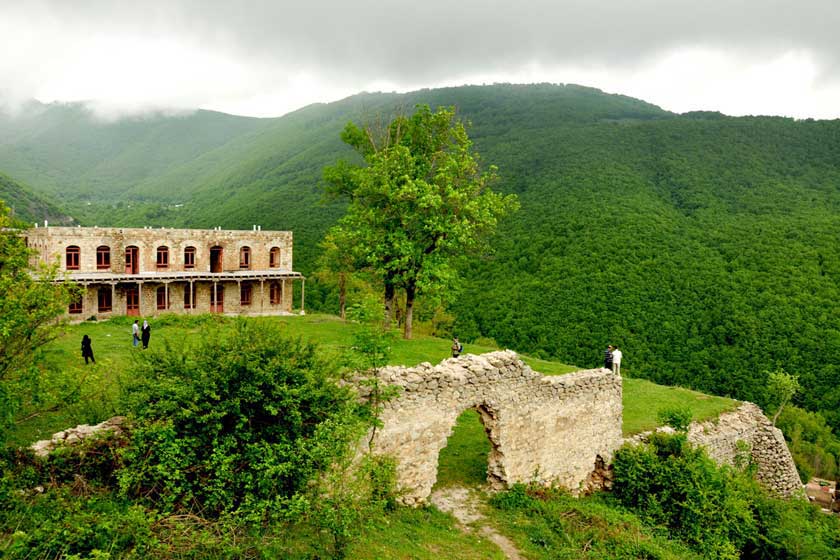East Azarbaijan province is a part of the ancient land of Madia until the time of Alexander and his successors, Azerbaijan was called a part of Madia or Little Madia. However, during the time of Alexander the Great, in 331 BC, a general named Aturpat or Atropatan, who was the mayor of the small Med area, rose up in this land, and then by concluding a treaty, he prevented Azerbaijan from being handed over to the Greeks. Alexander will leave him there on the condition that Atropate considers himself a subordinate of his empire. After Iskandar's death, bloodshed among his successors, Atropat became the ruler of this region, and in recognition of his services in preventing the influence of foreigners in this area, Mad Kochak was called Sardar Atropat, and then known by different names, Azar Badgan and Azar Abadgan. became.
During the Sassanid period, Azarpatkan was one of the important states of Iran and satrap as the Greeks say, which became known as Azarbaijan due to the existence of the famous fire temple of Azar Ghasab and other fire temples.
- History of Azerbaijan after Islam
Azerbaijan was considered one of the most important states of Iran in the Islamic period and has been the center of many events since the decline of the Sassanids until today and has played a major role in the course of history.
With the invasion of the Mongols and the arrival of Helakokhan, Azerbaijan became the center of the Mongol empire from Khorasan to the Levant. After the Mongols and the Turkic dynasty, the Qaraqyunluh and Aqqyunluh dominated this region, and then Shah Ismail I declared Tabriz as the capital of Iran. Later, during the Qajar period and during the reign of Feth Ali Shah Qajar, a part of Azerbaijan was handed over to Russia through treaties. Other names of this land are Iranvich, Azergashsab and Atorpadgan. After Fath Ali Shah, the city of Tabriz became the crown seat and Ahmad Shah, Naseruddin Shah, Muzaffaruddin Shah and finally Muhammad Ali Shah spent their time as governors in this city. In 1300, Reza Khan established the control of the central government of Iran over this region. With the start of World War II in 1320, Soviet forces entered the northern provinces of Iran, including Azerbaijan. These forces evacuated Azerbaijan in May 1325 after raising the issue of Azerbaijan in the United Nations. During the nationalization of the oil industry in 1329, the people of Azerbaijan started a struggle against British colonialism, and finally, with victory, England was defeated.
- The course of economic, political and cultural developments in Azerbaijan
The Azerbaijan region is one of the oldest Iranian civilizations and has a firm place in the ancient civilization of Iran. Tabriz, the historical center of this region, is an ancient city whose first historical signs date back to eight centuries BC, where the Assyrian King Sargon II's inscription mentions its conquest. According to the narrative of history, Azerbaijan was inhabited in very distant times and has economic, social and
It has had an impressive industry (in terms of being located on the Silk Road), in such a way that archaeologists attribute the texture of the oldest woven carpet (Pazyrak carpet) to this area.
Also, based on the observations and writings of famous travelers and tourists such as Yaqut Hamavi, Marco Polo, Ibn Battuta, etc., Tabriz city has many markets and its products have been exported to all parts of the world. The prosperity of the Tabriz market and the current economy in the city during the past centuries made the city a hotbed of international trade and supply and demand, and it had rich, wealthy and powerful people. In terms of culture, in addition to the printing industry, foreign books were first translated into Farsi in this city, and the art of translation was established in this city.
The first encyclopedia in the world of Islam and Christianity, the first public library, the first cinema and theater, the art of photography, modern carpets, the first novel, children's literature, national journalism, new poetry and literary criticism were established in this city. have been.
In the field of modern science and knowledge, the children of this region are the pioneers of modern medicine, mechanized agriculture, aviation, road and building construction, the creation of the first factories, the first municipality, the new trade (the first chamber of commerce), the first public company and After all, they are the first investment service center.
- Race, language and religion of the inhabitants of Azerbaijan
Azeris are the most authentic Iranian people who immigrated to this land three to four thousand years ago. These people were divided into Parthians and Medes, who settled in different parts of Iran, including the Medes who settled in Azerbaijan. The language of the people of Azerbaijan is Azerbaijani Turkish, and as a result of the passage of time, this language has evolved in its development due to close contact with other ethnic groups living in Iran, such as Persians, Arabs, Armenians, Georgians, Kurds, and other ethnic groups in terms of vocabulary and grammar. has been The current language of Tabriz people is Azari.
The common religions in Azerbaijan from the beginning until now have been the primary religions of the Aryans (Devism and Mehrism), Zoroastrianism, Judaism, Christianity and Islam. In terms of religion, 98% of the people of the province are Muslim and follow the Jafari Shia religion, and a minority of Christians, who are mostly Armenian and Gregorian, live in Tabriz.
